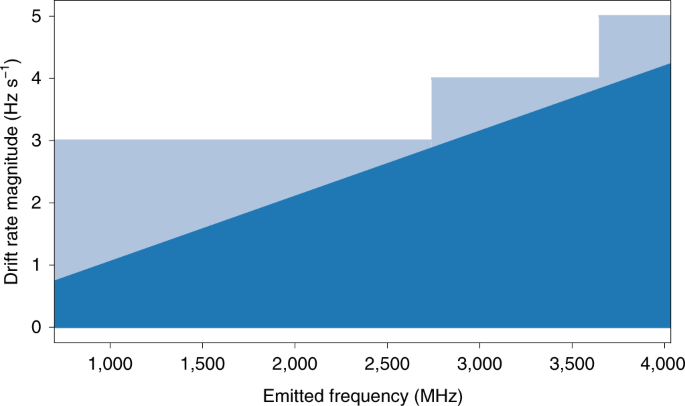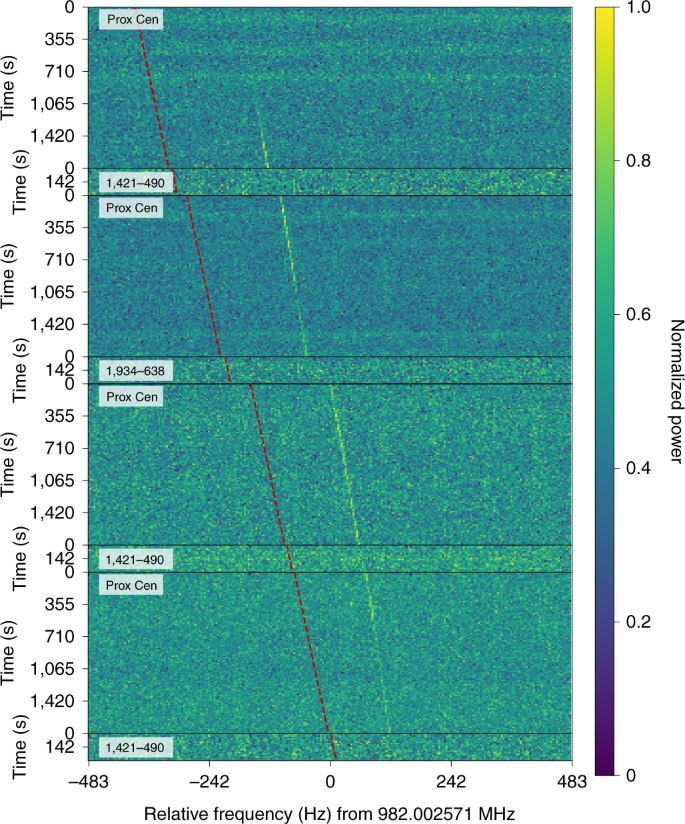A radio technosignature search towards Proxima Centauri resulting in a signal of interest
The discovery of the exoplanet Proxima Centauri b (Prox Cen b) in orbit around Prox Cen1 has sparked excitement over the prospect of a habitable exoplanet in the nearest reaches of the solar neighbourhood. Several studies2,3,4 suggest that Prox Cen b may be able to sustain an atmosphere favourable for life. However, because Prox Cen is an active M-dwarf flare star, doubt has been cast on the ability of Prox Cen b, which is in a much tighter orbit than Earth is to the Sun, to retain an atmosphere amenable to the existence of biological life. A naked-eye visible superflare strong enough to kill any known organisms has been observed from Prox Cen5, although life could still exist on the cold side of a tidally locked planet. Coronal mass ejections from Prox Cen have also been observed6,7, suggesting that Prox Cen b experiences appreciable ionizing radiation. Nevertheless, there remain compelling arguments that M-dwarf stars are viable hosts for life-bearing planets8, and Prox Cen b remains a compelling target for biosignature and technosignature searches.
Try Adsterra Earnings, it’s 100% Authentic to make money more and more.

Prox Cen b is also a candidate for in situ searches for extraterrestrial life by Breakthrough Starshot9. Starshot seeks to launch a gram-sized spacecraft propelled using a laser light sail at a relativistic velocity (0.2c) to the Alpha Centauri system with Prox Cen b as the primary target. If successful, the spacecraft will travel the 4.22 light yr to Prox Cen in 20 yr and then transmit information on its target(s) back to Earth.
Despite being our nearest stellar neighbour, few technosignature searches have been conducted towards Prox Cen. In the 1990s, two search for extraterrestrial intelligence (SETI) programmes were conducted in the southern hemisphere towards nearby stars: the Project Phoenix search of 202 solar-like stars10,11, and a search for technosignatures from 176 of the brightest stars12. Consequently, neither programme selected Prox Cen—a faint M dwarf—as a star target. Until a recent technosignature search of high-resolution optical spectra of Prox Cen13, no technosignature searches had been conducted at optical wavelengths. This search of archival data from the High Accuracy Radial Velocity Planet Searcher spectrometer between 2004 and 2019 would have revealed laser emission from Prox Cen with <120 kW power, and was motivated by the observations detailed here.
In this Article, we present a search for technosignatures from the direction of Prox Cen, using the CSIRO Parkes radio telescope (‘Murriyang’) as part of the Breakthrough Listen (BL) and the Breakthrough Initiatives search for life beyond Earth. BL—a sister initiative of Starshot—is a 10 yr programme to search for signs of intelligent life at radio and optical wavelengths14,15. BL has been conducting observations since 2016 and is undertaking the most rigorous and comprehensive observational SETI campaign to date16,17,18,19,20. Prox Cen is part of the BL survey sample of 60 stars within 5 pc (ref. 15), and was observed as part of a previous data release including 1,327 nearby stars17. These observations were conducted using the Parkes 10 cm receiver, covering 2.60–3.45 GHz. The observations presented here cover a larger bandwidth (0.7–4.0 GHz), with six times longer on-source dwell times (30 min). Our observations allow us to set the lowest equivalent isotropic radiated power (EIRP) detection limit for any stellar target.
We searched our observations towards Prox Cen for signs of technologically advanced life, across the full frequency range of the receiver (0.7–4.0 GHz). To search for narrowband technosignatures we exploit the fact that signals from any body with a non-zero radial acceleration relative to Earth, such as an exoplanet, solar system object or spacecraft, will exhibit a characteristic time-dependent drift in frequency (referred to as a drift rate) when detected by a receiver on Earth. We applied a search algorithm that detects narrowband signals with Doppler drift rates consistent with that expected from a transmitter located on the surface of Prox Cen b (Fig. 1). Our search detected a total of 4,172,702 hits—that is, narrowband signals detected above a signal-to-noise (S/N) threshold—in all on-source observations of Prox Cen and reference off-source observations. Of these, 5,160 hits were present in multiple on-source pointings towards Prox Cen, but were not detected in reference (off-source) pointings towards calibrator sources; we refer to these as ‘events’ (Table 1).

Dark blue is the calculated magnitude of the Doppler drift and light blue is the magnitude of the search range.
The total hits by frequency are shown in Fig. 2. As expected, our detection pipeline finds the majority of hits (57%) in ranges that have registered transmitters. Distributions of hits and events for our drift rate search range and S/N are shown in Fig. 3. Positive, negative and zero drift rates correspond to 10%, 15% and 75% of the total hits respectively. The slight bias towards a negative drift rate is due to non-geosynchronous satellites21. The majority of events occur below an S/N threshold of 103 because faint signals are less likely to be detected in our shorter reference observations. Stronger signals are also generally associated with nearby ground-based transmitters that will appear in both on-source and off-source observations.
Fig. 2: A histogram of total hits as a function of frequency (narrowband signals detected above S/N threshold) for our observations towards Prox Cen.
We used the turboSETI Doppler search code to search for narrowband signals with a Doppler drift across the 0.7–4.0 GHz bandwidth of the Parkes UWL receiver. Registered cellular, satellite and broadband internet transmitters in the Parkes area are overlaid.
Fig. 3: Histograms with total hits and events.
Search drift rates (top panel) and S/N (bottom panel). Blue bins are hits (signals detected by our data analysis pipeline) and orange bins are events (signals detected in all on-source observations, but not in off-source observations).
Of the 5,160 events, only one event (Fig. 4) passed all rounds of filtering and visual inspection of dynamic spectra. The event does not lie within the frequency range of any known local radiofrequency interference (RFI), and has many characteristics consistent with a putative transmitter located in another stellar system. This event, which we refer to as a signal of interest, has been previously reported as ‘BLC1’, short for ‘Breakthrough Listen Candidate 1’. We note that ‘signal of interest’ is more appropriate than ‘candidate’22, but for consistency we will adopt BLC1 throughout.
Fig. 4: The signal of interest, BLC1, from our search of Prox Cen.
Here, we plot the dynamic spectrum around the signal of interest over an eight-pointing cadence of on-source and off-source observations. BLC1 passes our coincidence filters and persists for over 2 h. The red dashed line, purposefully offset from the signal, shows the expected frequency based on the detected drift rate (0.038 Hz s−1) and start frequency in the first panel. BLC1 is analysed in detail in a companion paper23.
BLC1 was detected at 982.002571 MHz, with a drift rate of 0.038 Hz s−1. The signal of interest was detected over a ~2.5 h period, and is only present in pointings towards Prox Cen. According to the US Federal Communications Commission and the Australian Radiofrequency Spectrum Plan, BLC1 lies within a frequency band reserved for aeronautical radionavigation; however, no transmitters that operate at the detected frequency of BLC1 are registered within 1,000 km of the observatory. Radionavigation stations are ground based, so are less likely to be directionally sensitive. It is unlikely that an aircraft or satellite would be present in the direction of Prox Cen over the course of the signal of interest. BLC1 is analysed in further detail in a companion paper23. As detailed in the companion paper, we ultimately conclude that BLC1 is a complex intermodulation product of multiple human-generated interferers: not a technosignature.
Given our non-detection of technosignatures, we place limits on the detection of narrowband signals from Prox Cen by calculating the minimum detectable EIRP (EIRPmin). The EIRPmin is given by
$${{{{rm{EIRP}}}}}_{min }=4uppi {d}^{2}{F}_{min }$$
(1)
where d is the distance to the source (1.301 pc for Prox Cen) and Fmin is the minimum detectable flux in watts per square metre. The equation for Fmin depends on the minimum S/N (S/Nmin), the system temperature of the telescope (Tsys), the effective collecting area of the telescope (Aeff), the channel bandwidth (B), the number of polarizations (npol) and the total observation time (tobs)16,17:
$${{{{F}}}}_{min }={{{rm{S}}}}/{{{{rm{N}}}}}_{min }frac{2{k}_{rm{B}}{T}_{{{{rm{sys}}}}}}{{A}_{{{{rm{eff}}}}}}sqrt{frac{B}{{n}_{{{{rm{pol}}}}}{t}_{{{{rm{obs}}}}}}}.$$
(2)
kB is the Boltzmann constant. We calculate Fmin = 9.2 Jy Hz and EIRPmin = 1.9 GW. This EIRPmin is 3.6 times smaller than that previously reported, EIRPmin = 6.2 GW, for observations of Prox Cen17. The improved EIRPmin is due to the lower Tsys of the ultrawide-bandwidth, low-frequency receiver (UWL) (22 K), compared with the Parkes 10 cm receiver (35 K), and our longer tobs, 5 min versus 30 min. Additionally, our EIRPmin is 1.6 times smaller than Green Bank Telescope L-band (1.1–1.9 GHz) and S-band (1.7–2.6 GHz) observations of the second closest star outside the α Cen system, Barnard’s Star (GJ 699). As such, our search of Prox Cen is decisively a very sensitive and comprehensive technosignature search for a stellar target.
On the basis of previous SETI searches and analysis24, it is clear that putative narrowband transmitters are rare. As such, it is statistically probable that any signal of interest is a pathological case of human-generated interference. Extended and rigorous analysis of BLC1 was required to ascertain its progeny; this is presented in the companion paper23, alongside a framework for verification of future signals of interest.
Alone, this search—or more generally any band-limited single-target search—cannot disprove the existence of a technologically advanced society on Prox Cen b. While the UWL receiver has a wide bandwidth, we have still not covered the entire radio spectrum, nor optical, infrared or X-ray bands. In addition to false positives, RFI could also confound detection of technosignatures at coincident frequencies. Prox Cen remains an interesting target for technosignature searches, and we encourage continued observations with other facilities and alternative approaches.
More Story on Source:
*here*
A radio technosignature search towards Proxima Centauri resulting in a signal of interest
Published By

Latest entries
 allPost2024.11.23Slots Appoint Casino No Deposit Gratification Caractères 2024 #10
allPost2024.11.23Slots Appoint Casino No Deposit Gratification Caractères 2024 #10 allPost2024.11.23Geschäft or No Handel in den besten Live Casinos 2024 zum besten geben
allPost2024.11.23Geschäft or No Handel in den besten Live Casinos 2024 zum besten geben allPost2024.11.23Superiores Tragamonedas Colombia #11 Superior tragamonedas online
allPost2024.11.23Superiores Tragamonedas Colombia #11 Superior tragamonedas online allPost2024.11.23Ruby Slots Casino No Deposit Gratification Calcules 2024 #2
allPost2024.11.23Ruby Slots Casino No Deposit Gratification Calcules 2024 #2




2 replies on “A radio technosignature search towards Proxima Centauri resulting in a signal of interest”
cialis buy online usa Kang L, Wang ZY
69 Verapamil 40mg 16 generic cialis cost